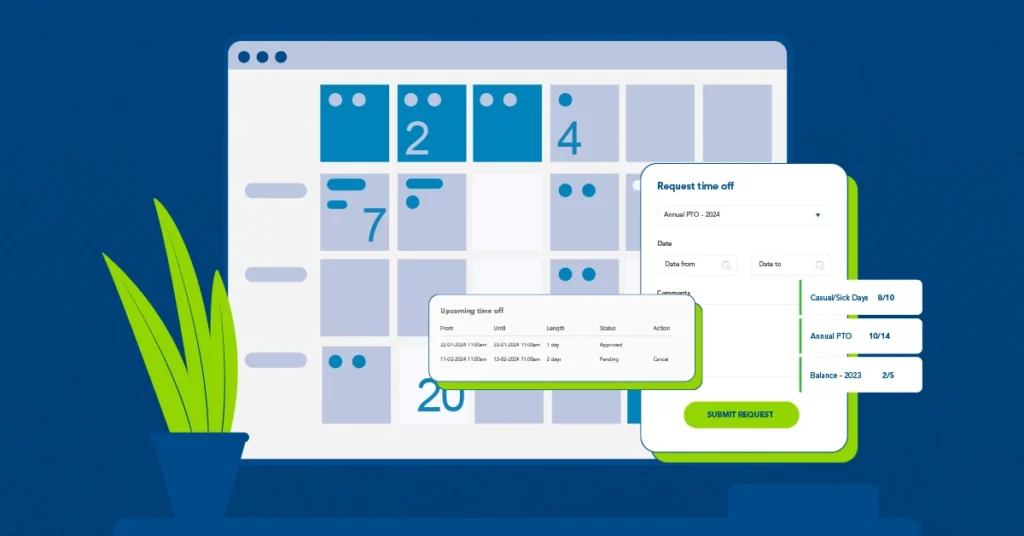Paid time off (PTO) may sound like a simple perk. But when it comes to how you calculate PTO or track and manage it, the details can get tricky fast.
Whether you’re an employee trying to figure out your PTO balance, or an HR professional trying to keep track, a uniform system makes all the difference for fairness, accuracy, and compliance.
In this guide, we’ll break down:
- The difference between accrued and lump-sum PTO
- How to manually calculate PTO
- Common accrual models used across organizations
- How to create a PTO policy
- Why PTO tracking is easier with leave management software
Let’s start with how PTO accruals work and why they matter.
PTO accrual vs. lump-sum
Before you can calculate PTO — whether manually or with automated software — you first need to know which system you’re working with: accruals or lump-sum. This foundational distinction shapes how time off is earned, tracked, and applied across your workforce.
What is PTO accrual?
Accrued PTO occurs when employees earn paid time off incrementally rather than receiving a fixed number of leave days at the start of each year. Employees accumulate a certain number of PTO hours or days based on the number of hours they work or their tenure with the company.
Employers may see this type of policy as more equitable, as it directly relates to the amount of time an employee has worked.
What is lump-sum PTO?
Lump-sum PTO is an alternative to accrued PTO, where employers grant a set amount of paid leave days at the start of each year or employment period. It’s straightforward and provides employees immediate access to their full leave entitlement.
Some organizations use lump-sum PTO as a way to elevate limited PTO policies, rather than opting for an unlimited PTO policy. Lump-sum PTO requires little calculation, as it’s predesignated and usually offered on a “use it or lose it” basis.
Calculate PTO accrual
If you choose to calculate PTO accruals manually, here are some basic steps you can take:
- Divide – Start by dividing the number of hours worked by the employee by the number of hours required to earn one hour of PTO. This gives you the total hours of PTO accrued.
- Subtract – If an employee has already used some PTO, subtract the used hours from the accrued hours to determine the remaining PTO.
- Multiply – Next, multiply the accrued PTO hours by the employee’s hourly wage to calculate the monetary value of the accrued PTO. Knowing the monetary value of an employee’s PTO is beneficial when performing operational functions like budgeting and reporting.
While these steps may be helpful to calculate PTO in real time, keep in mind that they’re not reliable for forecasting PTO. They don’t consider future PTO the employee has scheduled or provide insight into an employee’s projected PTO balance versus their current and scheduled balances.
Common types of PTO accrual policies
Companies can tailor their PTO accrual policies based on factors like employee needs and organizational resources. Common policy options include:
- Weekly PTO accrual – Typically used for full-time employees, this policy allows PTO to accumulate on a weekly basis.
- Example – An employee might earn 2 hours of PTO for every 40 hours worked weekly. To calculate this, divide 40 (weekly hours worked) by 20 (40/20 = 2 hours of PTO). If the employee’s hourly wage is $25, then the value of 2 hours of PTO is 2 x $25 = $50.
- Biweekly PTO accrual – A common approach for full-time employees, accruing PTO every two weeks.
- Example – An employee accrues 4 hours of PTO per 80 biweekly hours. So, divide 80 (biweekly hours worked) by 20 (80/20 = 4 hours of PTO). With an hourly wage of $25, the PTO value would be 4 x $25 = $100.
- Monthly PTO accrual – Often chosen for full-time staff, PTO accrues each month.
- Example – An employee accumulates one day (8 hours) of PTO each month. If an employee works 160 hours monthly, divide 160 by 20 (160/20 = 8 hours of PTO). At $25 per hour, the monthly PTO value equals 8 x $25 = $200.
- Yearly PTO accrual – This policy grants PTO annually, implemented for both part-time and full-time employees.
- Example – An employee receives 10 days (80 hours) of PTO at the start of the year. To calculate the annual value, if the hourly wage is $25, then 80 hours of PTO equals 80 x $25 = $2,000.
- Hourly PTO accrual – One of the more complex and less common options, this method is sometimes required by collective bargaining agreements (CBAs), contracts, and/or legal mandates. The complexity of hourly PTO accrual makes manual calculation methods challenging.
- Example – An employee earns 1 hour of PTO for every 30 hours worked. For example, if an employee works 120 hours in a period, they accrue 4 hours of PTO (120/30). At $25 per hour, this is valued at 4 x $25 = $100.
- Daily PTO accrual – Implemented for part-time and full-time employees, PTO accrues daily.
- Example – An employee earns 1 hour of PTO for each 8-hour workday, but no PTO for half days. Therefore, multiple the number of full-time days in a time period, careful not to overlap or count half-days.
Understanding these types of accruals helps you calculate PTO more accurately and choose an approach that best aligns with the needs of your workforce.
Other elements of a PTO accrual policy
There’s no one-size-fits-all to how you should calculate PTO, whether you’re covering policy or accruals. You want to choose an approach that aligns with your goals, keeps you in line legally, and allows you to offer your team the benefits they deserve.
Considering these components can help you build a PTO policy tailored to your organization:
Stair-stepping
This policy offers varying amounts of PTO based on an employee’s length of service. First-year employees might get two weeks of PTO, which increases to three weeks in year two, rewarding longevity and commitment to the organization.
Resets
You may choose a “use it or lose it” policy, where employees cash in PTO within a given timeframe, typically by year-end. Alternatively, a reset policy may allow employees to carry over only a certain number of PTO hours into the next year.
Caps
This rule sets a maximum limit on the amount of PTO an employee can accumulate. Once the employee reaches this cap, they must use some of their accrued PTO before accruing more.
Compensatory (comp) time
Employees earn additional time off instead of receiving overtime pay for extra hours worked. This approach is critical to manage correctly, as it involves actual hours worked and must comply with legal compensation requirements.
For example, an employee could work 10 hours of overtime and receive 15 hours of comp time in return (as overtime pay is time and a half).
Different rules for different groups
You may choose to tailor your PTO policy to specific employee groups, often based on union membership, contract terms, seniority, types of employment, or job roles. For instance, unionized employees might have a different PTO accrual rate or cap compared to non-union employees, reflecting the terms negotiated in the CBA.
Payouts
You may opt to pay employees for unused PTO at the end of the year. This not only clears out your PTO balance each year, but it can also help alleviate the year-end rush and de-risk your organization from losing labor availability at critical times.
Each state has different laws governing whether payouts are mandatory or not. It’s important to maintain compliance with PTO payout laws in your state, especially when employees leave the company.
PTO Payout Laws by State
| State | PTO Payouts in Place by Law? |
| Alabama | No |
| Alaska | No |
| Arizona | No |
| Arkansas | No |
| California | Yes, via the state website |
| Colorado | Yes, via the state website |
| Connecticut | No |
| District of Columbia | Yes, barring any written agreement otherwise, via the state website |
| Florida | No |
| Georgia | No |
| Hawaii | No |
| Idaho | No |
| Illinois | Yes, barring any written agreement otherwise, via the state website |
| Indiana | Yes, via the state website |
| Iowa | No |
| Kansas | No |
| Kentucky | Yes, via the state website |
| Louisiana | Yes, barring any written agreement otherwise, via the state website |
| Maine | Yes, via the state website |
| Maryland | Yes, barring any written agreement otherwise, via the state website |
| Massachusetts | Yes, via the state website |
| Michigan | No |
| Minnesota | Yes, barring any written agreement otherwise |
| Mississippi | No |
| Missouri | No |
| Montana | Yes, via the state website |
| Nebraska | Yes, via the state website |
| Nevada | No |
| New Hampshire | No |
| New Jersey | No |
| New Mexico | No |
| New York | Yes, barring any written agreement otherwise, via the state website |
| North Carolina | Yes, via the state website |
| North Dakota | Yes, via the state website |
| Ohio | No |
| Oklahoma | No |
| Oregon | No |
| Pennsylvania | No |
| Rhode Island | Yes, via the state website |
| South Carolina | Yes, barring any written agreement otherwise, via the state website |
| South Dakota | No |
| Tennessee | No |
| Texas | No |
| Utah | No |
| Vermont | No |
| Virginia | No |
| Washington | No |
| Wisconsin | Yes, barring any written agreement otherwise, via the state website |
| Wyoming | Yes, barring any written agreement otherwise, via the state website |
How to create a PTO policy
Once you’ve established how your accruals are calculated, the real work begins for establishing a PTO policy. This will look different for every organization, but here are some foundational steps to help you get started:
1. Choose the right type of PTO policy for your organization
While it’s smart to consider the PTO policies your competitors offer, it’s even more important to be sure the policy you implement will be the right fit for your organization. Take a close look at factors such as:
- Your organizational culture
- Your customer, community, or patient demands
- The type of shifts or schedules employees work
- Your overall priorities and requirements
Then, assess those factors against each type of policy you’re interested in to determine which will benefit your operations and your employees the most.
2. Make sure your PTO policy supports compliance
Compliance is a critical aspect when you need to calculate PTO and ensuring it fits your policy. Employees must receive the protections they’re entitled to and keeps organizations from facing non-compliance penalties. Don’t forget to examine applicable employment laws, union collective bargaining agreements (CBAs), and internal policies as you start crafting your policy.
Once you’ve identified the regulations that apply to your workforce, software can help relieve the stress of staying compliant and avoiding human errors that can lead to financial and reputational risks.
3. Communicate the PTO policy clearly
Even the most well-crafted PTO policy won’t do your organization or your team any good if it’s not properly communicated. How will employees access policy documentation or receive notifications if and when relevant rules change?
How you communicate and provide access to your PTO policy can directly impact how employees understand, plan for, and use their PTO. Be sure to implement reliable and consistent procedures to ensure everyone knows the current policy and any subsequent changes.
4. Establish rules for PTO requests and approvals
Fairness and consistency are crucial when enforcing PTO policies for your employees. If one manager handles requests and approvals differently, it can lead to serious resentment and dissatisfaction among employees.
This highlights the importance of establishing crystal-clear rules for both managers and employees about when and how they should request, approve, or deny PTO.
An effective PTO system benefits you, your employees, and your organization’s performance.
How leave management software doubles as a PTO time tracker
Tracking and managing all the details around a PTO policy and management process is enough to make any manager’s head spin.
Fortunately, you can minimize the heavy lifting by leveraging the right tools. A robust PTO time tracker can help automate accruals or calculate PTO, monitor usage trends, and reduce administrative burden. This makes it easy for employees to understand, access, and request available time off and enables managers to handle those requests seamlessly. No extra time and hassling over manual processes.
That way, employees can take their well-deserved PTO, and managers can track the data they need to maintain operations while team members are out of the office.
Automate your PTO process with TCP Software
Insufficient, manual, or outdated processes can make developing and managing an effective PTO policy nearly impossible.
A lack of visibility into accrual banks and PTO forecasts means managers waste precious time evaluating requests and risk approving unearned PTO. Add inadequate transparency between managers and employees, and you’re stuck with inconsistent time off approvals, perceived favoritism, and reduced team morale.
But TCP’s leave, absence, and accrual management software flips this dynamic on its head.
Your organization can easily calculate PTO and manage its policies and processes. Our intuitive platform offers 24/7 self-service access across multiple devices (including mobile, so employees and managers have everything they need at their fingertips to understand, request, evaluate, approve, and track PTO without sacrificing their productivity.
Automated request tracking, notifications, and one-click request approvals make handle PTO-related tasks a breeze. No more wasted time or silly errors.
TimeClock Plus offers:
- Configuration based on complex rules, including internal policies, state and federal labor laws, and CBAs
- Automations for accrual calculations by type of leave policy, including flat accrual rates, accrual based on hours worked, and configurable distribution periods
- Accrual forecasting based on employee hours, accrual rules, and existing leave requests
Because you shouldn’t have to choose between meeting your goals and giving your employees the time off they deserve, regardless of how complex your needs are.
TCP Software’s employee scheduling and time and attendance solutions have the flexibility and scalability to suit your business and your employees, now and as you grow.
From TimeClock Plus, which automates even the most complex payroll calculations and leave management requests, to Humanity Schedule for dynamic employee scheduling that saves you time and money, we have everything you need to meet your organization’s needs, no matter how unique. Plus, with Aladtec, we offer 24/7 public safety scheduling solutions for your hometown heroes.
Ready to learn how TCP Software takes the pain out of employee scheduling and time tracking? Speak with an expert today.



